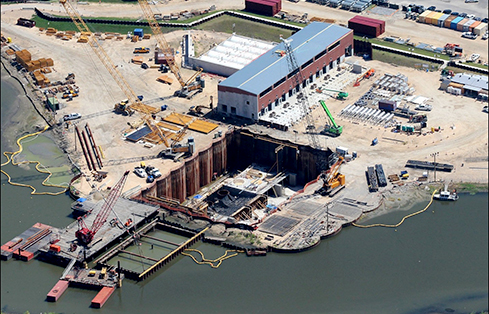 By taking a performance-based engineering approach on the Pier 54 project, the GeoEngineers team was able to model the interaction between both wood and steel piles with the potentially liquefiable soil in which they would be anchored.
By taking a performance-based engineering approach on the Pier 54 project, the GeoEngineers team was able to model the interaction between both wood and steel piles with the potentially liquefiable soil in which they would be anchored. Construction on ground improvements at Port of Portland’s Terminal 6, where our team used a PBE approach to maximize limited resources.
Construction on ground improvements at Port of Portland’s Terminal 6, where our team used a PBE approach to maximize limited resources. The OPEN CELL Cofferdam during excavation for the 17th Street Canal Pump Station. Photo courtesy of PCCP.
The OPEN CELL Cofferdam during excavation for the 17th Street Canal Pump Station. Photo courtesy of PCCP. Using a PBE approach, GeoEngineers retrofitted many of the aging wood trestles throughout the Washington State Ferry System.
Using a PBE approach, GeoEngineers retrofitted many of the aging wood trestles throughout the Washington State Ferry System.
Performance-Based Design
Improving safety and maximizing investment with a cutting-edge approach to engineering design
Performance-based design (PBD) is an alternative approach to absolute factor-of-safety engineering standards. Using complex analytical software, PBD evaluates the reliability of a design by modeling a variety of real-world loads and conditions a structure is expected to face.
PBD can be especially valuable when working with soft ground and in seismically active regions. In these more complex conditions, conventional force-based and factor-of-safety analysis often isn’t adequate to develop a design that performs satisfactorily.
No prediction can be perfect, and PBD is probabilistic, but by predicting a structure’s performance before it is built, we can evaluate risk factors over a structure’s entire life cycle and incorporate the consequences of various types of structural failure. This information helps owners meet regulatory requirements and prioritize investment where the need is greatest.
With a grounding in these advanced design approaches and methods, we are helping make the next wave of infrastructure built in the United States and around the world more resilient, affordable and safe.
Evolving Standards in Seismic Analysis and Design
In most jurisdictions, buildings must meet International Building Code standards defined by the American Society of Civil Engineers (ASCE). The most recent ASCE 7-16 building code came with big changes to seismic design standards. Instead of allowing mapped ground motion parameters for many projects, the new code requires site-specific ground motion analysis—even at lower-risk sites.
Performance-based design (PBD) is a natural response to the new seismic requirements in ASCE 7-16. In fact, the building code itself formally recognizes and permits using well-established performance-based approaches for conventional building design. This more rigorous approach could potentially mean higher costs and more design time, but that increase can be off-set in construction thanks to the potential decrease in seismic loads (up to 20 percent) under a more precise model.
GeoEngineers has completed dozens of projects with site-specific PBD analysis in Washington State and Oregon, two early adopters of ASCE 7-16, and for sites in South Carolina, Utah and Idaho. As jurisdictions continue to adopt the new building code, GeoEngineers is working with local staff across the country to apply the lessons we have learned to each new market. Our PBD approach to ground motion hazard analysis can provide more realistic predictions and risk assessments, giving our clients and partners the confidence to design both efficiently and safely.
